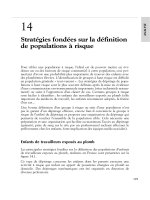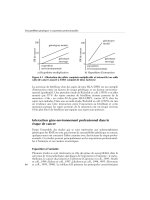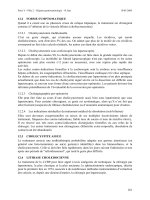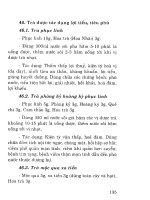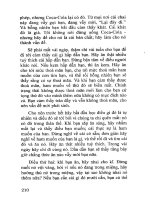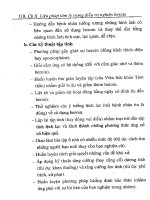Kaplan anatomy coloring book - part 7 pot
Bạn đang xem bản rút gọn của tài liệu. Xem và tải ngay bản đầy đủ của tài liệu tại đây (809.85 KB, 21 trang )
NOSE
AND
NASAL
SEPTUM
The nose consists of the nasal
bones,
the
frontal
process
of
the
maxilla at
the root
of
the nose, and a
number
of cartilages. These nasal cartilages
are made of hyaline cartilage. These
are the lateral nasalcartilages, the
greater
alar
cartilages, and the
lesser
alar
cartilages. The septal
cartilage also forms
part
of these
cartilages. The openings of the nose
(nostrils) are the
external
nares
(external
naris
singular).
The nasal cavity has a wall
that
runs
down the middle of it called the
nasal
septum.
The septum consists
of three parts, the
perpendicular
plate
of
the
ethmoid
bone
(a
continuation of the
crista
galli) , the
vomer
and the septal cartilage. At
the end of the nasal septum are two
holes that separate the nasal cavity
from the
nasopharynx.
These are
the
choanae
or
internal
nares. The
floor of the nasal cavity is bordered
by the
hard
palate
and the soft
palate. At the junction of the crista
galli and the perpendicular plate of
the ethmoid is the
cribriform
plate
of the ethmoid. Label the various
structures of the nose such as the
bones and color in the cartilages of
the nose.
Answer Key: a.
Nasal
bone, b.
Frontal
processof
maxilla,
c.
Septal
cartilage,
d.
Lateral
nasal
cartilage,
e.
Lesser
alar
cartilages,
f. Greateralar
cartilage,
g.
External
naris,
h.
Crista
galliof
ethmoid bone,
i. Cnbnform plate,
J.
Perpendicular plate of ethmoid bone,
k.
Vomer,
I.Hard palate,m. Soft palate,
n.
Choanae
(internal nares)
a.
b. _
g
h. _
1. _
a. _
J
k. _
c
_
f. _
1.
_
Chapter
Ten
I
IlAPLA~.
I 2
Respiratory System
meulca
5:5
ll
LATERAL
WALL
OF
NASAL
CAVITY
AND
RESPIRATORY
EPITHELIUM
When looking at the nasal cavity, if
the septal cartilage is removed you
can see the nasal conchae. These
structures force the inhaled air to
come into contact with the wall of
the nasal cavity where the air is
warmed and moistened. There are
three nasal conchae, the
superior
nasal concha, the
middle
nasal
concha, and the
inferior
nasal
concha. Note the position of the
conchae with the nasal bone, the
hard
palate and the soft palate.
Label the nasal cavity and the
structures that are associated with
the cavity.
c.
a
b. _
d. _
e. _
Chapter Ten I
KAPLAlf
d
-
I
255
Respiratory System me lea
f
The nasal cavity islined with
respiratory
epithelium
which is
pseudostratifiedciliated
columnar
epithelium
with goblet cells.
Respiratory epithelium isfound in
the nasal cavity, the lower larynx,
trachea, and bronchi. The goblet
cellssecrete
mucus
which forms a
film over the epithelial surface. Dust
and other particulate matter sticks to
the
mucous
sheet which is moved by
the cilia. This provides a protective
function, removing particulate
matter from entering the lungs
where it might do damage. Label the
various parts of respiratory
epithelium such as the nucleus, cilia,
mucous
sheet, goblet cells, and
basement
membrane.
Answer Key:a.
Nasal
bone, b. Superior
nasal
concha,
c.Middle
nasal
concha,
d. Infenor
nasal
concha,
e. Hard
palate,
f. Soft
palate,
g. Mucous sheet,h.
Cilia,
i Goblet
cells,
j
Nuclei,
k. Basement
membrane
Chapter
Ten
I
KAPLAlf
d
"
I 257
Respiratory System me lea
CORONAL
VIEW
OF THE
NASAL
CONCHAE
AND
LARYNX
The nasal cavity ismore than a hole behind the nose. Inhaled air swirls
around the conchae and is warmed and moistened in the process. Label
and color the septalcartilage in a coronal section of the nose. Label and
color each of the conchae. The
superior
nasal concha, middle nasal
concha, and the
inferior
nasal concha should each havea different
color. The frontal and
ethmoid
sinuses can also be seen in this
illustration. They give resonance to the voice. Note the location of the
hard
palate and the external naris in this coronal section. The larynx is
also sectioned in this plane and the position of the thyroid cartilage, the
vocal fold, the cricoidcartilage, and the
trachea
are seen in this view.
Label and color the rest of the structures in this illustration.
f. _
e. _
g
a. _
d. _
- c. _
If//lli,
\\
~(~h.
D~~~
;:-
~[-
IV
- k.
Q::=
10
0-
0
\
1.
_
Answer Key: a.
Sinuses,
b. Superiornasalconcha,c.Middle nasalconcha,d.
Septal
cartilage,
e. Inferior
nasal
concha,f. Hardpalate,g.
External
naris,
h. Thyroid
cartilage,
i.
Vocal
fold,
J.
Cricoid
cartilage,
k.
Trachea
Chapter
Ten
Respiratory System
I
IAPLA~.
I
meulC8
259
LARYNX
AND
TRACH
EA
The
larynx
is the "voice box" and it not only produces sound for speech
but also separates the flow of air to the lungs from the flow of foods and
liquids that go down the esophagus. The
thyroid
cartilage is the largest
cartilage of the larynx and it iseasily seen from the anterior aspect. The
thyroid cartilage is inferior to the hyoid bone. Behind the thyroid
cartilage is the epiglottis which is the only laryngeal structure made of
elastic cartilage. Inferior to the thyroid cartilage is the cricoid cartilage
and it is the inferior border of the larynx. The
cricothyroid
ligament
joins these anterior structures together. Above the cricoid cartilage are
the paired
arytenoid
cartilages. These attach to the vocal folds and
tighten them, causing the voice to increase in pitch. Superior to the
arytenoid cartilages are the corniculatecartilages
that
are shaped like
small horns. The glottis is the opening into the larynx and the epiglottis
is the flap that folds over the glottis during swallowing.
In the midsagittal section of the larynx you can see that the cricoid
cartilage is larger on the posterior aspect. The
thyroid
cartilage is
prominent on the anterior side, the
arytenoid
and corniculate
cartilages are prominent on the posterior side, along with the cricoid
cartilage, the epiglottis, and the vocal folds. The vestibularfold (false
vocal cord) is superior and is found on the lateral wall of the larynx.
Below this is the vocal cord (vocal fold) thatproduces sound. The conus
elasticus consists of elastic tissue and connects the vocal folds to the
cartilages. Below the larynx is the
trachea
which leads from the larynx to
the lungs. Label and color the structures of the larynx and label and
color in the trachea.
Answer Key:a.
Epiglottis,
b. Hyoidbone,c.
Thyroid
cartilage,
d.
Corniculate
cartilage,
e.
Vestibular
fold, f.
Vocal
fold, g.
Arytenoid
cartilage,
h.
Conus
elasticus,
i.
Cricothyroid
ligament,
j.
Cricoid
cartilage,
k.
Trachea,
I.
Glottis
THE
TRACH
EA
AND
BRONCHIAL
TREE
The
trachea
connects to the larynx
superiorly and ends inferiorly in a
keel-shaped structure called the
carina. The trachea is composed of
the
tracheal
rings
which are hyaline
cartilage. The posterior surface of
the trachea has
smooth
muscle
called the trachealis
muscle
that
allows for the food in the esophagus
to bulge into the trachea. The
trachea branches into the
right
primary
bronchus
and the left
primary
bronchus
which form
part
of the lungs.
b. _
Chapter Ten I UPLANd·· I 261
Respiratory System me lea
Answer Key: a.
Trachea,
b. Right
primary bronchus,
c.
Tracheal
ring,
d. Leftprimary bronchus,e.
Carina,
f.
Trachealis
muscle
LUNGS
AND
MEMBRANES
The lungs are in the
thoracic
cavity
on either side of the mediastinum.
The membrane that occurs on the
inside of the ribs and on the superior
aspect of the diaphragm isknown as
the parietalpleura. The space inside
of this is the
pleural
cavity and the
lungs occupy the pleural cavities.
The innermost membrane is the
visceral
pleura
and it is attached to
the surface of the lung. The right
lung has three lobes: a
superior
lobe,
a
middle
lobe, and an
inferior
lobe.
The left lung has two lobes: a
superior
lobe and an
inferior
lobe.
The left lung also has an indentation
where the heart protrudes into the
left lung and this is the cardiac
notch. Labelthe membranes and the
parts of the lungs and color them in.
Chapter
Ten
I 1
m
APe
LANd'
-Ical
263
Respiratory System
b _
c. _
d _
e _
Answer Key:a.
Parietal
pleura,
b.
Visceral
pleura,
c.
Superior
lobe,
d. Middle lobe,e Inferiorlobe,
f.
Cardiac
notch,g.
Pleural
cavity,
h.
Trachea
\;C~!
h.
~'
r.
(~\
L\
\
\\-b
~(
'\"!:,
"'=~~~:::::::::::J
g.
Chapter
Ten
Respiratory System
I
UPLA~.
I
memea
265
THE
PATHWAY
OF
AIR
The lungs are like large sponges
filled with microscopic spaces. Air
travels to these spaces by the
bronchial
tree. The trachea splits at
the level of the lungs into two
primary
bronchi.
Each lung has a
primary bronchus that divides to
secondary
bronchi. These divide
further to
tertiary
bronchi
which
divide into smaller branches. Finally
bronchi become
bronchioles
and
these lead to smaller sacs where the
exchange of oxygen
and
carbon
dioxide occurs between the lungs
and
blood. Shade the major
segments of the bronchial tree.
The air from the bronchioles moves
into the alveolar
ducts
which are
part
of the clusters called alveolar
sacs. The air flows into the alveolar
duct which is a conduit to the
individual alveoli (alveolus
singular)
and
these are the areas
where there is an exchange of oxygen
and
carbon dioxide between the air
and
blood. Capillaries are situated
next to the alveoli
and
there are two
thin set of
membranes-one
of the
alveolus and one of the
capillary-
that allow the exchange of oxygen
and carbon dioxide. Additionally
there are
type
II alveolarcells
(septal cells) that secrete a material
called surfactant. This substance
reduces the surface tension of the
lungs, allowing
them
to expand
more easily.Color in the structures
of the alveolar sacs
and
the
associated structures.
Answer Key:a.
Cartilage,
b.
Secondary
bronchus,
c.
Tertiary
bronchus,
d.
Bronchi,
e.
Bronchioles,
f.
Alveoli,
g.
Capillaries,
h.TypeII alveolarcell
(septalcell), i.
Surfactant,
j.
Red
blood
cell,k.
Alveolus,
I.
Pulmonary
artery,
m.
Alveolar
ducts,
n. Pulmonaryvein,
o.
Alveolar
sac
1.
a. _
c. _
g._
~h
I
rc~
k.
'\1\
J
m. _
f. _
d
e
Chapter
Eleven:
Digestive
System
267
1.
J.
OVERVIEW
OF THE
DIGESTIVE
SYSTEM
The digestive system is composed of a long tube called the
alimentary
canal and the accessory
organs
including the liver, pancreas, and gall
bladder. The alimentary canal starts at the
mouth,
includes the
esophagus, stomach, intestines, and rectum and terminates at the anus.
It can be defined as the tube through which ingested products move. The
accessory organs have digestive functions but they do
not
come into
contact with material passing through the digestive tract. The alimentary
canal consists of numerous organs including the
mouth
which is the
opening to the system and is directly anterior to the oral cavity.The
terminal aspect of the oral cavity is defined by the small mass of fleshy
tissue called the uvula. Posterior to the oral cavity is the oropharynx.
This chamber receivesfood and liquid from the
mouth
and air from
a. _
b. _
c. _
d. _
e
f. _
1.
_
m
both the
mouth
and nasal cavity.The oropharynx leads to the
esophagus which is a muscular tube that takes ingested material to the
stomach. The stomach is a storage organ leading to the small intestine
where material isdigested and absorbed. The large intestine receives
material from the small intestine, removes a significant amount of water,
and stores the fecal material prior to defecation.
The salivaryglands are the most superior accessory glands. They
lubricate food and add digestive enzymes to material that is swallowed.
The liver,
pancreas
and gall
bladder
all add secretions to the ingested
material and aid in the digestive process. Label the parts of the digestive
system, includingthe alimentary canal and the accessory organs, and
color the individual digestive organs a different color.
h. _
Answer Key: a.Alimentary
canal.
b. Mouth, c.
Esophagus,
d.
Stomach,
e. Small Intestine, f.
Large
intestine,g.
Accessory
organs,
h.
Salivary
glands,
i.
Liver,
J.
Pancreas,
k. Gall
bladder,
I.
Rectum,
m. Anus
MOUTH
AND
ORAL
CAVITY
The
mouth
is the entrance to the
digestive system. It is bordered by
the two labia or lips. Each labium
has a labial
frenulum
(superior
and
inferior) that holds the lip to the
gingiva. The gingiva (gums) have a
surface tissue
of
stratified squamous
epithelium which is the cell type that
lines the entire oral cavity. The oral
cavity encloses the teeth,
and
the
tongue. It is bordered by the
hard
palate, the softpalate, the uvula, the
cheek walls,the muscles
and
associated tissue that spans across
the bodies of the mandible. The oral
cavity leads to the
oropharynx,
which in
turn
leads to the
esophagus.
The
tongue
is a large muscle in the
oral cavity that pushes food to the
posterior
part
of the oral cavity for
swallowing
and
helps form speech. It
is held to the floor
of
the oral cavity
by the lingual frenulum.
Answer
Key:
a.
Superior
labial
frenulum,
b.
Gingiva,
c.
Hard
palate,
d. Soft
palate,
e.
Uvula,
f.
Oropharynx,
g.
Tongue,
h.
Inferior
labial
frenulum,
i.
Esophagus
g._
Chapter Eleven \ IAPLAlf
il
-
I
269
Digestive System me lea
';7;-;77777777c-''-=-::+~
C. _
d. _
g._
h. _
SALIVARY
GLANDS
The three pair of salivary glands secrete saliva inside the oral cavity.The
largest pair consists of the
parotid
glands and they are located just
anterior to the ears. The
parotid
duct
leads from the gland to posterior
to the upper second molar. The
submandibular
glands are located
Tongue
Buccinator muscle
Mandible
a.
Chapter
Eleven
I
IlAPLAlI"d-
I 271
Digestive System me lea
inferior to the mandible and they take secretions to either side of the
lingual frenulum. The sublingual glands are inferior to the tongue and
have many tubes
that
lead to the lower oral cavity.Label the salivary
glands and the parotid duct. Color each gland a different color.
c.
_
Mylohyoid muscle
Answer
Key:
a.
Sublingual
gland,
b. Submandibulargland,c.
Parotid
gland,
d.
Parotid
dud
Chapter Eleven
Digestive System
I
mettical
273
TEETH
h. _
k.
-~
~
.
~CJ"-/
~U
\I~
Deciduous
.:
m::;~~'Y
Permanent
maxillary
teeth
l
•.• •
: .
\ .
~.
i
d
~
:
·
,':" '0
.:J~
('~
c. _
a
b.~
Answer
Key:
a.
Crown,
b.
Neck,
c.
Root,
d. Enamel, e. Dentin, f. Pulp cavity,
g. Periodontal ligament, h. Root canal,
i. Cementum,
J.
Apical foramen,
k. Blood vessels and nerves,
I.Incisors,
m. Cuspids (canines), n. Premolars
(bic.ispids), o. Molars
The tooth has three general regions:
the crown, the neck, and the root. The
crown is the part of the tooth that
erupts from the gums into the oral
cavity.The neck is normally at the
levelof the gingiva and the
root
is
imbedded into the bone. The tooth
fits into the alveolar socket of the
maxilla or the mandible and is held
there by the
periodontal
ligaments.
The internal anatomy of the
tooth
reveals the hard
enamel
which is an
extremely dense material that resists
wear and abrasion. Deep
to this is
the
dentin,
a material similar to
bone that provides the major
structure of the tooth. In the root,
the dentin is coated with
cementum
that helps fix the tooth in the
alveolar socket. Inside of the dentin
is the
pulp
cavity
that
houses nerves
and
blood
vessels. These structures
enter the tooth by the apical
foramen
and make their way to the
pulp
cavity by the
root
canal.
Humans have two series of teeth.
Early in development come the
deciduous
(milk) teeth. The
permanent
teeth
emerge as the skull
is increasing in size. In deciduous
teeth there are incisors,
cuspids
(canines), and
molar
teeth
but there
are no premolars. In adults there are
the
incisor
teeth, the
cuspids,
premolars
(bicuspids), and
molar
teeth. Label the parts of the tooth
and then color in the regions of the
tooth on one side of the illustration
and the enamel, dentin,
and
other
features on the
other
part
of the
illustration. For the deciduous and
permanent
teeth, use the same color
for the incisors on
both
illustrations.
Use another color for the cuspids
and
another
for the premolars, and
so on for the rest
of
the teeth.
ESOPHAGUS
Food moves from the
oral
cavity to
the
oropharynx
by action of the
tongue. The uvula flips upward
keeping the food from entering the
nasal cavity. Food passes from the
oropharynx into the laryngopharynx
before moving to the esophagus. The
food enters the esophagus as a
lump
or bolus and passes through the
esophageal
sphincter
to the stom-
ach. Once it enters the stomach the
bolus mixes with stomach fluid and
becomes a liquid called chyme. Label
and color the structures leading to
the esophagus
and
the esophagus
itself including the esophageal
sphincter.
a. _
\\
c
__
Chapter Eleven I
KAPLAlf
d
- I
275
Digestive
System me lea
\
~
•.
~~
:'Uc<imtoc muscle
~
t~·····.·::·\
1/1
\'
········~e
.
'''c-~-7/
\ .
'\\f ~
I Cricoid cartilage
I
f. _
Answer Key: a.
Oropharynx,
b.
Laryngopharynx,
c.
Esophagus,
d.
Uvula,
e.Oral
caVity,
f.
Stomach,
g.
Esophageal
sphincter
Open
Closed
g._
Chapter Eleven
Digestive System
I
meclical
277
STOMACH
The stomach is located on the left side of the body, just inferior to the
diaphragm.
It
is the part of the alimentary canal located between the
esophagus and the small intestine. The stomach has an upper cardia and
a small domed portion called the fundus. The stomach contents are
restricted from flowing back into the esophagus by the esophageal
sphincter. If stomach fluid refluxes into the esophagus, it is felt as
"heartburn."
The main portion of the stomach is the
body
and the narrow region,
leading to the
duodenum
is the
antrum
or pyloric region. This leads to
the pyloric canal which is controlled by the pyloricsphincter. The
greater
curvature
is located on the left edge of the stomach and the
lesser
curvature
is on the right side. The stomach has inner ridges called
rugae
which allow for expansion of the stomach.
The stomach has many layers. The inner layer is called the mucosa which
is rich in glands that secrete acids and inactive enzymes such as
pepsinogen into the stomach cavity.Pepsinogen is activated by
hydrochloric acid. The mucosa has gastric pits with parietal cells and
chief
cells emptying into the pits. The parietal cells secrete hydrochloric
acid and the chief cellssecrete pepsinogen. External to the mucosa is the
submucosa
and this layer has many blood vesselsimbedded in
connective tissue. Beyond this is the muscularis. In the stomach there
are three layers of the muscularis. These are the obliquelayer, circular
layer, and
longitudinal
layer. The most external layer is the serosa (also
known as the visceral
peritoneum)
and this is next to the abdominal
cavity. Label the parts of the stomach and color them in. Color the layers
of the muscularis using different colors of red or pink for each layer.
Color the general regions of the stomach different colors along with the
separate sphincters.
a. _
b _
c
Muscularis layers:
1. _
m. _
0
_
n. _
-t •
-t .
q
{
f.
Muscularis e. _
layers d.
~-==;::=:======S~~::'~-';c=
r. _
p._
Answer Key: a.
Fundus,
b.
Cardia,
c.
Lesser
curvature, d. Longitudinallayer(of muscularis),e.
Circular
layer(of muscularis),f. Oblique layer(of muscularis), g.
Body,
h.
Rugae,
i. Greater
curvature,
J.
Pyloric
canal,
k. Pyloricsphincter, I.Antrum, m. Gastricpit, n. Chiefcell,o.
Parietal
cell,p.
Mucosa,
q.
Submucosa,
r.
Serosa
Chapter Eleven
Digestive System
I
meilical
279
SMALL
I
NTESTI
NE
e
f. _
g
.',.
"~-···-h.
_
b. _
c. _
,.
~
.
d. _
c. _
e
(Lower
tnree-nttns)
a.
Answer Key: a, Gallbladder,
b.
Pancreas,
c. Duodenum, d Jejunum,
e. Ileum,
f.
Circular
fold, g,
Villi,
h.
Submucosa,
i
Muscularis
The small intestine receives the
contents of the stomach, continues
the process of digestion and absorbs
nutrients. The first part of the small
intestine is the
duodenum,
a
short
tube of about twelve inches in
length, that receives material from
the stomach, enzymes and buffers
from the pancreas, and bile from the
gall bladder. The
duodenum
has
circular
folds in the wall that
increase the surface area. The
jejunum
is the next section of the
small intestine and it makes up
about forty percent of the small
intestine. There are
circular
folds in
the
jejunum
as well. The
ileum
is the
terminal
portion
of the small
intestine and represents about sixty
percent of the small intestine. The
small intestine is small in diameter
and that is how it gets its name.
The small intestine is distinguished
from the rest of the alimentary canal
by the presence of villi. These'small
structures in the mucosa increase the
surface area of the small intestine
and house blood capillaries and
lacteals for the absorption of
nutrients. The small intestine has the
four layers typical of the other
organs of the gastrointestinal tract:
the mucosa,
submucosa,
muscularis.
and serosa. Label the
parts of the small intestine and color
in the various regions and layers of
the small intestine.
LARGE
INTESTINE
The large intestine is shorter than
the small intestine
but
has greater
width. The large intestine begins in
the lower right
quadrant
of the
abdomen with a sac-like structure
called the cecum. The ileocecal valve
is a muscular sphincter that prevents
the fecal material in the cecum from
flowing back into the ileum. At this
junction is the
vermiform
appendix. Material in the large
intestine moves from the cecum to
the ascending
colon
and then makes
a sharp
turn
at the
hepatic
flexure.
Once this
turn
is accomplished, the
material is in the transverse colon.
From here there is a sharp
downward angle called the splenic
flexure and the material enters the
descending colon. From the
descending colon, the material
enters an S-shaped tube called the
sigmoid
colon
and then enters the
rectum. The rectum is the end of the
large intestine. The rectum leads to
the
anal
canal which is a
short
tube
leading to the anus.
There are several anatomical features
that separate the large intestine from
the small intestine. The large
intestine has long strips of
smooth
muscle that
run
the length of the
large intestine. These are called the
teniae coli. These muscles pull the
intestine into small compartments
called
haustra.
Another
distinguishing feature of the large
intestine is the presence of small fat
globules called epiploicappendages.
Label the parts
of
the large intestine
and color in each region with a
different color. Color the haustra
light red and the tenia coli pink.
Color the epiploic appendages
yellow.
Answer Key: a. Hepaticflexure,
b. Splenic
flexure,
c.
Transverse
colon,
d. Descendingcolon, e. Epiploic
appendages,
f.
Sigmoid
colon,
g. Redum, h. Anal
canal,
i,Anus.
j.Vermiformappendix,k.Cecum,
I.
Ascending
colon, m.
Tenia
coli,
n.
Haustra
a. _
1
_
k. _
J
Chapter
Eleven
I
KAPLAlf
d
-
I 281
Digestive System me lea
b. _
c. _
f. _
g._
~0
1.
e.
n. _
Chapter Eleven I
mKAPeLANd'
-Ical
Digestive System
281
1.
_
~~~(
•
••••••
-:
'
••
: :
•••••••
c::::::"~
"
'
~Q
~:
~[
~
. .
I~\
\
J
k. _
Liver Lobule
~\
C. g. _
b. _
1. _
d.
'
e. _
h. _
a. _
Answer
Key:
a.
Right
lobe, b.
Left
lobe,
c.
Falciform
ligament,d.
Portal
vein,
e. Hepatic
artery f.Caudate lobe,
g.Quadrate lobe, h.
Portal
triad,
i.
Centralvein,j.
Bile
duct,
k.
Hepatic
artery branch,
I.
Bile
canaliculus,
m.
Portal
vein branch, n. Hepatocytes,
o. Sinusoids
LIVER
The liver is the largest internal
organ
of the body. It is on the right side
of
the body and plays a major
metabolic function in digestion
and
also in processing material from the
blood. The liver has four lobes in
humans
and is held to the
diaphragm
by the falciform
ligament.
The
right
lobe
is the
largest of the lobes. The left
lobe
is
also reasonably large. The
quadrate
lobe
is anterior
and
is rectangular in
shape
when
seen from the inferior
view. The
caudate
lobe
is a
posterior
lobe of the liver.
The blood flows into the liver from
two sources. The
hepatic
portal
vein
takes
blood
to the liver from the
digestive
tract
and
some
abdominal
organs. The
hepatic
artery
brings
oxygenated
blood
to the liver. The
liver is composed of microscopic
sections called liver lobules. These
are typically hexagonal
columns
that
have a
central
vein
that
takes
blood
back to the heart via the hepatic
vein. Blood travels to the central vein
by
sinusoids,
canals
that
are lined by
hepatocytes
(liver cells).
Hepatocytes clean the
blood
or
process material in the blood. Old
blood pigments are recycled by the
liver and are converted to bile. The
bile moves
through
bile
canaliculi
and
eventually is stored in the gall
bladder. The branches of
the
hepatic
artery,
portal
vein,
and
bile
duct
are
clustered together
and
form the
portal
triad.
Label the liver
structures on the illustrations. Color
in the lobes of the liver using
different colors for each lobe.
Color
the hepatic portal vein blue, the
hepatic artery red,
and
the bile ducts
green.
Chapter Eleven I
KmAPeLAN
d
'
-Ical
285
Digestive
System
J
b _
d. _
1. _
g._
h. _
a. _
c. _
The gall bladder receives bile from
the liver, storing and condensing it
prior to secreting it into the small
intestine. Bile is an emulsifier of fats,
making them disperse in the liquid
chyme of the digestive tract. Bile
flows from the
left and right hepatic
ducts,
into the common hepatic
duct, into the cystic duct then
entering the gall bladder.
When
the
gall bladder contracts, bile moves
back
out
the cystic duct
and
into the
common bile duct before entering
the small intestine. Usually the
common
bile duct and the
pancreatic duct join before they
enter the small intestine. In this case
the tube is called the
hepatopancreatic ampulla
and
it
leads to the
duodenal papilla. Label
the parts of the pancreas, gall
bladder and ducts and color
them
in.
Answer
Key: a. Gall bladder,
b.
Pancreas,
c.
Duodenum,
d.
Head,
e. Body,
f.
Tail,
g Right hepatic duct,
h Cystic duct, i. Duodenal papilla,
j. Left
hepatic duct, k.
Common
hepatic duct,
I.
Common bile duct, m. Pancreatic duct
The pancreas is a complex organ
that has
both
a digestive function
and an endocrine function. The
digestive function of the pancreas
consists of producing enzymes for
the digestion of materials in the
small intestine
and
the secretion of
buffers to increase the pH of the
fluid secreted from the stomach. The
pancreas has a
head, next to the
duodenum,
a main body
and
a tail
near the spleen. The enzymes
and
buffers secreted into the small
intestine flow into the
pancreatic
duct
before entering the small
intestine.
PANCREAS/
GALL
BLADDER
OVERVI
EW
OF THE
URI
NARY
SYSTEM
The urinary system consists of two
kidneys, two ureters, a urinary
bladder,
and a urethra. The right
kidney isa
little more inferior than
the left kidney due to the presence of
the liver on the right side of the
body. The kidneys are located near
the twelfth vertebra and extend to
the third lumbar vertebra. They
receiveblood from the
renal artery.
The kidneys are retroperitoneal,
meaning that they are posterior to
the parietal peritoneum. The ureters
are also retroperitoneal and take
urine to the bladder. Since the
urinary bladder islocated anterior to
the parietal peritoneum it is called
anteperitoneal. Label the organs of
the urinary system
and
use separate
colors for the kidneys, ureters,
urinary bladder, and urethra.
Chapter
Twelve:
Urinary
System
287
k
_~
(.~\
\
' I
d
.
~
) \
~
.\
!
Answer
Key: a.
Kidney,
b.
Ureter,
c.
Urinary
bladder,
d.
Urethra,
e.
Renal
artery
a. _
b. _
c. _
' ;
Psoas major muscle
Chapter Twelve
Urinary System
I
UPLANd'· I
me lea
289
KIDNEY
The kidney is a bean-shaped organ.
The outer surface of the kidney is
covered by the
renal
capsule. The
depression on the medial side is the
hilum
where the
renal
artery
enters
the kidney and the
renal
vein and
the
ureter
exit. The kidney is
sectioned in the coronal plane to
study the internal anatomy. The
renal capsule is a thin
membrane
on
the exterior of the kidney. Deep to
the capsule is the renal
cortex
where
filtration takes place in the kidney.
The renal
medulla
is deep to the
cortex and it is divided into renal
columns
and renal
pyramids.
Each
pyramid ends in a papilla and this
drips urine into smalJ funnel-shaped
structures called the
minor
calyces
(calyx singular). The
minor
calyces
join to form the
major
calyces and
these, in turn, take urine to the
renal
pelvis. The renal pelvis occupies
most of the
renal
sinus, a space in
the kidney. The renal pelvis takes
urine to the ureter on the medial
side of the kidney. Blood travels to
the kidney by the renal
artery.
From
there the blood moves into
segmental
arteries
and
then
interlobar
arteries. From the
interlobar arteries the blood travels
to the
arcuate
arteries. These
arteries are the dividing structures
between the renal cortex and the
renal medulla. From the arcuate
arteries blood flows into the
interlobular
arteries. Label the parts
of the kidney
and
associated
structures. Use one color for the
cortex and different shades of
another color for the renal pyramids
and columns. Color the renal artery
red and the renal vein blue. Use
yellow for the pelvis and ureter.
Answer Key: a.
Renal
artery,
b. Hilum,
c.
Renal
vein, d.
Renal
pelvis,e.
Ureter,
f.
Renal
capsule,
g. Major
calyces,
h.
Renal
sinus,I.
Renal
cortex,
J.
Renal
pyramid (in renal medulla), k.
Papilla,
I.
Renal
column, m. Minor
calyces,
n.
Segmental
arteries,
o. Interlobar
artery,
p. Interlobular
artery,
q.
Arcuate
arteries
a. _
b.
~~ c__I
c. _
d. _
e. _
f. _
g._
h. _
d. _
e. _
n. _
a. _
n. _
p._
q._
URINARY
BLADDER
The
urinary
bladder
is a storage
organ for holding urine. The
ureters
enter the bladder at the
ureteral
orifices and the urethra exits the
bladder inferiorly. These three
openings make a triangular region
known as the
trigone
at the
posterior wall of the bladder. The
urethra
is the external tube
that
takes urine voided from the
urinary
bladder to outside the body. The
urethra in the female is
much
shorter
than
in the male, which
makes females more susceptible to
bladder infections. The wall of the
bladder consists of
smooth
muscle
called the
detrusor
muscle
and an
inner lining of transitional
epithelium. Label the features of the
bladder, urethra, and associated
structures and color
them
in.
Answer Key: a.
Ureter,
b. Urinary
bladder,
c. Detrusormuscle,
d.
Ureteral
orifice,e.
Trigone,
f.
Urethra,
g.
Right
kidney
Chapter Twelve I
meClical
291
Urinary System
Peritoneum
Urethral sphincter muscle
Female
Urinary
System
g
a.
b
_
Prostate gland
"-, ;-
f.
Male
Urinary
System
Chapter
Twelve
I
mKAPeLANd'
-Ical
293
Urinary System
a. _
d
b
_
1.,
a. _
~
~.
h._
J
f
_
rT
g
e
The functional unit of the kidney is
the
nephron.
It is here that material
is filtered from the blood; some
material is lost in the urine while
other
material is reabsorbed back
into the cardiovascular system. The
renal
corpuscle of the nephron
includes the
glomerulus
and the
glomerular
(Bowman's) capsule.
The lining of the capsule wraps
around the glomerulus
and
filtered
material enters the nephron at this
point. The glomerular capsule leads
to the
proximal
convoluted tubule.
This tubule has a brush border
consisting of many microvilli
and
it
provides for a great surface area for
reabsorption of materials. Most of
the reabsorption of material in the
nephron occurs here. The
peritubular capillaries wrap
around
the kidney tubules
and
reabsorb the
filtered material. From the proximal
convoluted tubule, the fluid flows
into the
nephron
loop (loop
of
Henle). The nephron loop takes
fluid to the distal convoluted
tubule. From here the filtrate flows
into a collecting duct. Collecting
ducts receive fluid from many
nephrons. Label the parts of the
nephron
and
associated structures
and color them in. Each
part
of
the
nephron should be colored a
different color.
THE
NEPHROI\J
h _
To
minor
calyx
Answer
Key: a. Glomerulus, b. Distal
convoluted tubule,
c. Proximal
convoluted tubule, d. Cortex,
e. Medulla,
f.
Arcuate vein, g. Arcuate
artery, h. Nephron loop (loop of Henle),
I. Nephron,
J.
Collecting duct, k. Afferent
arteriole,
I.Efferent arteriole,
m. Glomerular (Bowman's) capsule
k. _
b. _
1.
_


